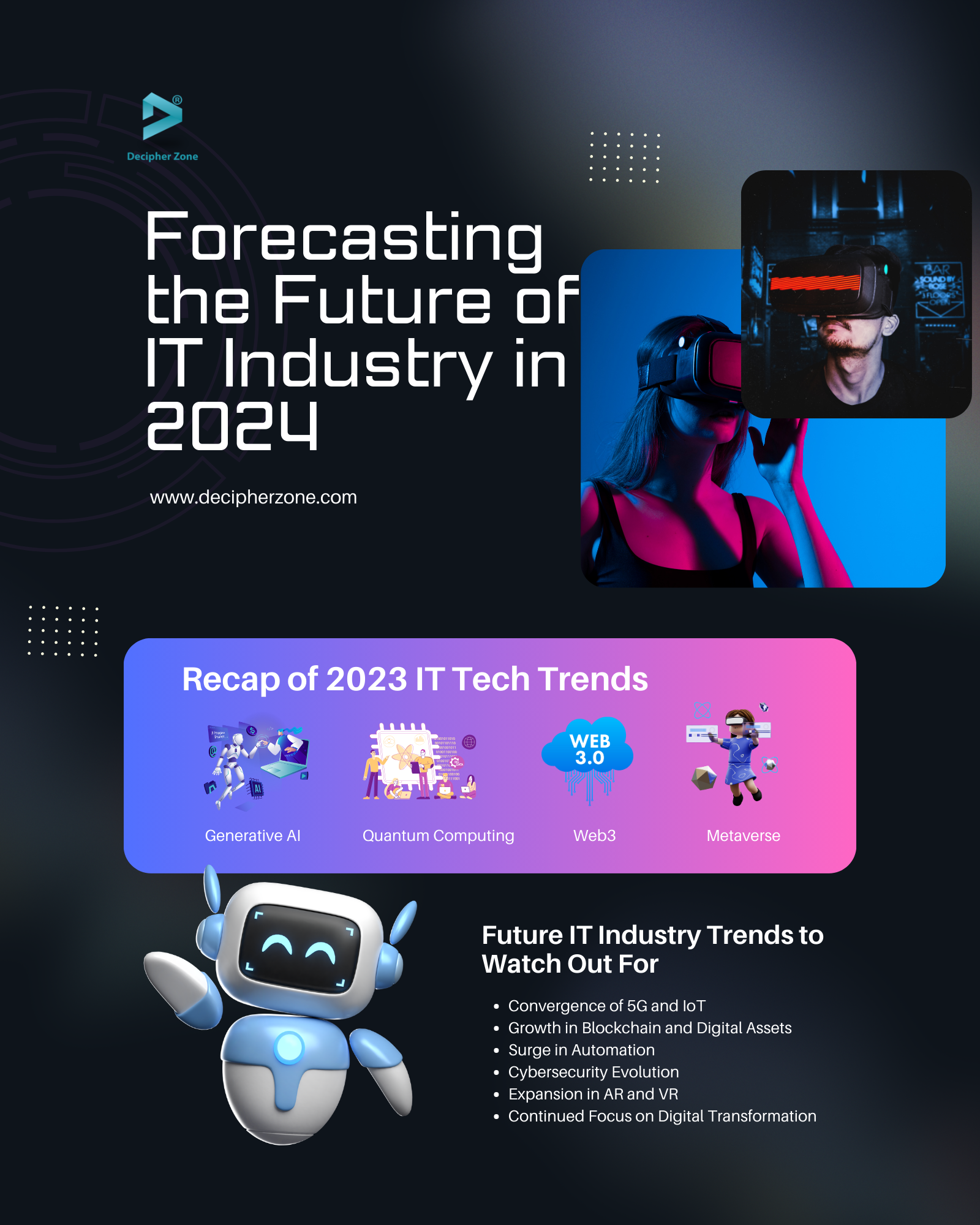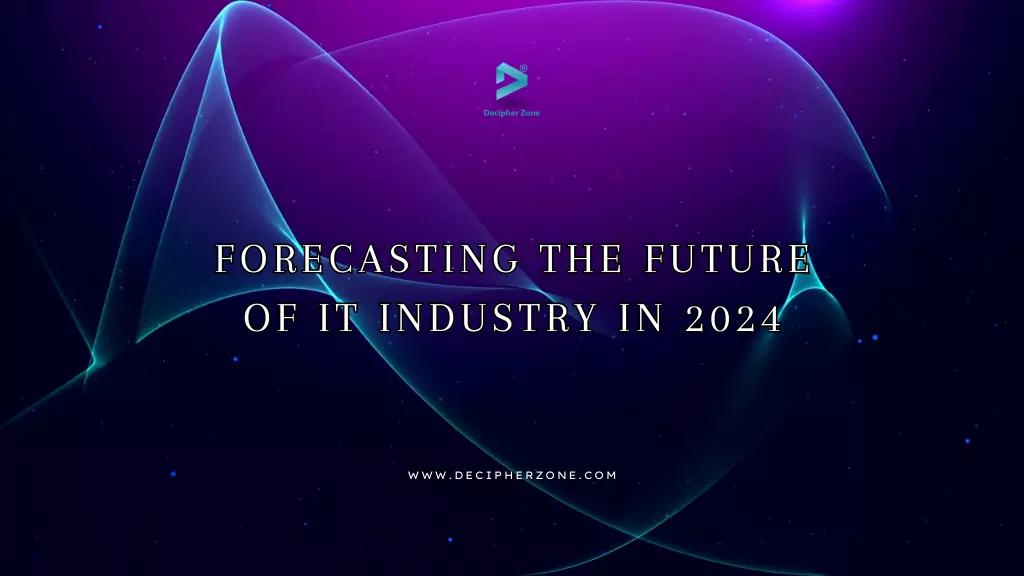According to a report by Statista, the global IT services revenue is projected to reach a massive 1771.00 billion USD by 2028, with a compound annual growth rate of 6.7%. Given this, it won’t be wrong to say that the information technology (IT) industry is expanding rapidly and is anticipated to continue doing so. Therefore, businesses must stay current with IT advancements to succeed in the ever-changing industry of 2024.
To help you, we will explore the future of the IT industry in 2024, providing insights through which you can stay informed about what to expect.
However, before exploring current industry trends, let’s look at the tech trends we witnessed in 2023.
Read: Impact of IT Industry on Current Business
Top 10 Future IT Industry Trends to Watch Out For 2024
Some of the top10 tech trends that we witnessed in 2024 for IT industry:
1. Generative AI Everywhere
AI was primarily utilized for comprehension and suggestions before 2023, but with the emergence of Gen AI, it can produce content utilizing technologies such as Generative Adversarial Networks (GANs), Large Language Models (LLMs), and Variational Autoencoders (VAEs). The content produced can manifest in the form of texts, images, audio, and synthetic data.
In 2023, we will witness the exponential rise and adoption of generative artificial intelligence products such as ChatGPT, Copilot, Scribe, and Bard. According to Bloomberg, Generative AI growth can expand at a CAGR of 42% and reach a $1.3 trillion market by 2032.
Read: Software Development Trends
2. Quantum Computing
The global quantum computing market was estimated to be worth $866 million in 2023, according to a report by MarketsandMarkets. The same report projected that the market would grow to $4,375 million by 2028.
Using quantum mechanics and classical computing, quantum computing is an interdisciplinary field that solves complex problems. While quantum computing has not achieved many practical applications yet, it is moving out of the university labs and slowly making its way into development and industrial facilities.
Some of the practical applications of quantum computing can be found in enhanced encryptions and security, complex simulations, materials science, optimization problems, machine learning, and artificial intelligence.
Read: Top 10 Web Technologies
3. Progress in Web3
Web3 is a concept that involves building a decentralized internet using blockchain technology. The majority of applications today are managed by centralized entities, which control how data is stored and used.
However, web3 aims to create community-driven projects where end-users can decide on pricing, data control, and technical development. This means that users have a greater say in how these projects are run, rather than just being passive consumers.
While 2023 didn’t mark explosive progress in Web3 as predicted, it has still brought a period of foundational advancements that set the stage for future advances.
But thanks to Web3’s decentralization, semantic web, trustlessness, and interoperability, the estimated market size of web3 was around $2.18 billion in 2023 based on a report from Precedence Research. It is also predicted that the global market size of Web3 will continue to grow at a CAGR of 46% and hit $65.78 billion by 2032.
Read: The Future of Payment Gateways
4. The Metaverse
The term metaverse refers to virtual worlds where users can interact in 3D as avatars. It has been the topic of discussion in the last few years where the vision is to build a single, immersive, shared, 3D virtual world where humans can experience life that isn’t possible physically.
That being said, according to MarketsandMarkets, the global market size of the metaverse technology has surpassed 83.9 billion USD in 2023. It is also projected to reach a whopping $1303.4 billion by growing at a CAGR of 48% by 2030.
Also, Gartner predicts that the metaverse will be fully device-agnostic and not under the ownership of any one particular manufacturer. It will incorporate its virtual economy, which will be empowered with digital currencies and non-fungible tokens (NFTs).
5. Convergence of 5G and IoT
The boundaries between the physical and digital worlds are expected to blur with the convergence of 5G, IoT, and AI. Not only that but this convergence will bring unprecedented possibilities for efficiency, innovation, and automation.
5G and IoT together will empower higher transmission speed while connecting more devices to the internet than ever. This will allow real-time communication and data exchange between devices.
According to the report from Markets and Markets, the demand for 5G IoT globally is expected to reach $58.7 billion from existing $13.2 billion by 2028. Some of the transformative impacts that 5G IoT convergence has brought to the industry are precision healthcare, autonomous systems, industrial automation, and smart city planning.
Read: The Future of Software Development

6. Growth in Blockchain & Digital Assets
Based on a report from FTI Technology, the majority of financial services organizations’ leaders consider blockchain investment a must in the next 12 months. About 85% of businesses have a positive outlook on the impact of blockchain in the future. Another report by Statista suggests that the CAGR of digital assets between 2024 and 2028 will remain 8.77%, resulting in a market size of $112,100 million by 2028.
In the upcoming years, AI will help blockchain detect fraud through pattern optimization, bring mainstream blockchain into production, reduce errors, and improve efficiency. The utilization of the central bank's digital currency experiments will become more popular as a means of value conversion.
The adoption of real-world tokenization of assets will speed up as a reliable method for financial transactions. There will be a movement to reinforce and standardize DeFi applications following the disruption with centralized exchanges. This push has the potential to increase adoption and establish decentralized alternatives to traditional financial services such as lending, borrowing, and trading.
7. Surge in Automation
The industrial automation market has undergone a steady evolution. It was estimated to have reached 147.9 billion in 2023. Now the industrial automation market is anticipated to hit 218.8 billion USD by 2028, according to the stats shared by Markets and Markets.
It is safe to say that automation is now an essential part of the industry rather than being an option. With the help of automation, there has been a significant improvement in the social perception of this technology.
Instead of replacing human labor, automation has created new job opportunities. It benefits manufacturers and producers by improving efficiency, productivity, and return on investment. As more industries adopt automation, it is poised to be one of the major technologies transforming the production and supply chain sector.
Read: How AI is Changing The Future of eCommerce
8. Cybersecurity Evolution
With the evolution of technology comes advancements in deception techniques by cybercriminals. They have everything to deceive unaware public officials and consumers through AI-based threats.
According to the Statista report, the global cybersecurity market size will grow at a CAGR of 10.56% and hit $273.6 billion by 2028. Thus, in 2024, we will witness more businesses adopting cybersecurity practices such as data encryption, smart authentication, real-time anomaly detection, security awareness training, multi-factor authentication, single sign-on, log monitoring, and firewall implementation.
9. Expansion in AR and VR
Acumen Research and Consulting reported that the augmented and virtual reality (AR and VR) global market will reach $451.5 billion by 2030. We will notice a massive growth in the adoption of AR and VR among businesses in 2024.
This massive adoption of AR and VR will be for product development and testing, training and employee onboarding, creating engaging customer experiences, gaining instant data insights, streamlining product design and prototyping, easier collaboration, and enhancing productivity.
Read: Best Augmented Reality App Development
10. Continued Focus on Digital Transformation
According to a recent report by Spherical Insights & Consulting, the global digital transformation market was valued at USD 1,258.4 Billion in 2022, and it is expected to grow to USD 10,571.7 Billion by 2032. This highlights the increasing importance of digital transformation across industries as businesses strive to keep up with the rapidly evolving technological landscape.
Therefore, in today's fast-paced business world, digital transformation is no longer a luxury but a necessity for all types of companies. It has become a crucial part of their strategy as they aim to stay ahead of the competition by adopting innovative technologies, efficient work processes, and data-driven decision-making.
Conclusion
Technology advancements in the current dynamic business landscape are constantly reshaping trends and creating new opportunities. As a result, businesses that wish to remain competitive must keep a close eye on the latest developments and be prepared to adjust their strategies accordingly. Whether embracing new tools and platforms, exploring innovative cybersecurity techniques, or rethinking traditional business models, staying ahead of the curve is essential for success.
By staying attuned to the latest trends and leveraging emerging technologies, businesses can position themselves for growth and thrive in an ever-changing market.
And if you want to take advantage of these opportunities in the IT industry by developing software that aligns with these trends, get in touch with our experts today!
FAQs: Forecasting the Future of IT Industry in 2024
-
Why do IT trends matter?
Keeping track of technology trends helps businesses stay competitive and relevant, retain customers, save time, and gain opportunities.
-
What are current IT trends in 2024?
In 2024, we will see a surge in blockchain, automation, 5G, IoT, AR, VR, and digital transformation.
-
What is the next big thing in IT technology?
Augmented and virtual reality will be the next big technology that will dominate the IT market this year.

